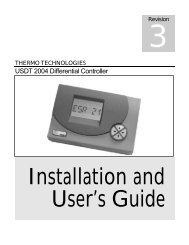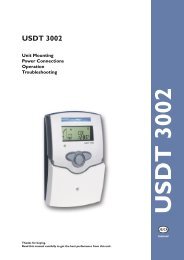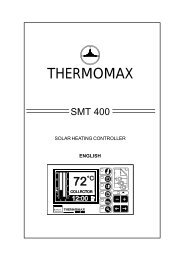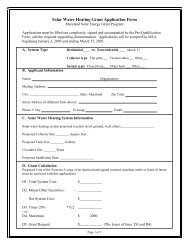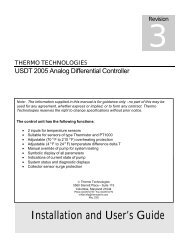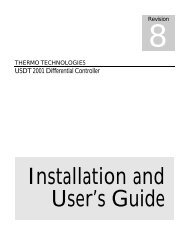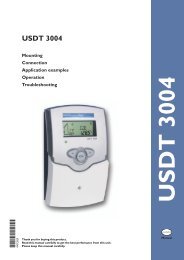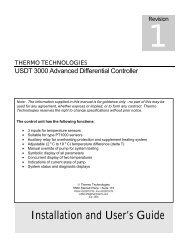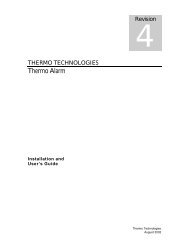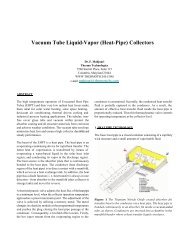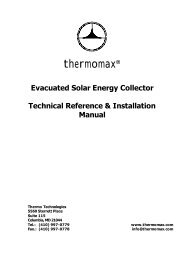SMT 100 Temperature Differential Controller - Thermomax ...
SMT 100 Temperature Differential Controller - Thermomax ...
SMT 100 Temperature Differential Controller - Thermomax ...
You also want an ePaper? Increase the reach of your titles
YUMPU automatically turns print PDFs into web optimized ePapers that Google loves.
1 Remove the two side restraining screws at both sides of the device.<br />
2 Separate the “Top”, controller -section from the Connecting “base”<br />
3 If your cables are to enter the enclosure from behind the unit, then knock out<br />
the appropriate entries in the “base” of the <strong>SMT</strong> <strong>100</strong>.<br />
4 Use the “base” of the enclosure to mark the four corner mounting holes.<br />
Remove “base” and drill all necessary holes in the wall or mounting panel.<br />
5 Connect supply cables, heating pumps and auxiliary output according to the<br />
wiring diagrams shown in section 2.3.<br />
2.2 SENSORS<br />
Included are three temperature sensors, collector, tank and return. If<br />
required, sensors are available with extended cable lengths or alternatively,<br />
sensor extenders are available, also in a variety of lengths. If the sensors<br />
need to be extended but factory-made extenders are not available, they can<br />
be extended using a suitable 4 core or 3-core cable, according to the diagram<br />
shown below.<br />
As with all PT<strong>100</strong> sensor applications, a good connection is vital. It is<br />
therefore recommended that wherever there is any doubt, a factory-extended<br />
sensor or a sensor extender should be used.<br />
2.3 POWER CONNECTIONS AND WIRING DIAGRAM<br />
Note: This device should be properly earthed. Flexible wires simplify<br />
connection to the terminals. All connections should be secure and<br />
adequately tightened, though not over-tightened, as loose power<br />
connections will over-heat, and may cause fire. It is important that the<br />
specified output loads are not exceeded. Where these loads may be<br />
exceeded, external contactors should be used. It is good practice to keep<br />
mains cables away from sensor cables and other low voltage signal cables.<br />
Note: If the outputs from the Auxiliary relay are required to drive a heater with<br />
a current rating greater than 3A then a contactor should be used.<br />
<strong>Thermomax</strong> can supply an intermediate device, which may be connected to<br />
the <strong>SMT</strong> <strong>100</strong> to drive an auxiliary load of up to 16A - Part No: C0328.<br />
4



